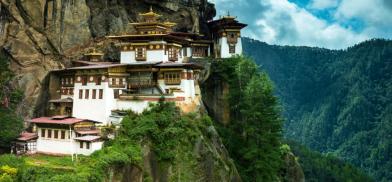Bhutan's draft tourism policy calls for all-season tourism
When tourism reopens after Covid-19 pandemic, the government will have to take measures to promote tourism as a year-round activity

When tourism reopens after Covid-19 pandemic, the government will have to take measures to promote tourism as a year-round activity. It should also encourage the spread of tourism activities in tourism deficient regions of Bhutan. This is according to the draft Tourism Policy of Bhutan 2020 that passed the review of Gross National Happiness Commission on July 3.
The draft policy, which will be the first tourism policy document after tourism started in 1974, will be submitted to the Cabinet for approval.
The policy is expected to be approved this month, according to the director general of Tourism Council of Bhutan, Dorji Dhradhul. The delay in the approval of policy was attributed to Covid-19.
The government will have to support the tourism industry in the identification, development and promotion of tourism products and services to establish a year-round destination.
“Measures such as the increase in visits during the lean season by adopting off-season marketing strategies such as targeted marketing and promotion. It should also encourage seasonal-based promotional offers,” said Dorji Dhradhul.
He said that pre-Covid-19 Bhutan used to lose tourists because the tourist season was for only six months.
“This is why we realised it was better to spread the tourists visit over 12 months,” Dorji Dhradhul said. “It will not affect the number of arrivals, but it is an opportunity to get different tourists where they want to visit Bhutan during different times.”
He said that for instance, Bhutan received more than 100,000 tourists in six months and if the numbers were spread, it would have less pressure on tourism.
From the first group of 287 tourists visiting Bhutan in 1974, Bhutan received a total of 315,599 tourists in 2019, according to the TCB record. This is an increase of 15 percent over 2018.
The highest number of arrival is in April, May and October and the number drops by almost four percent between February and July.
The draft policy would ensure that TCB in collaboration with local governments and relevant stakeholders would identify and develop tourism products and services to balance tourism in all the regions.
As per the policy statement, development of tourism infrastructure in the tourism deficient regions would be encouraged through provisions of differing incentives.
As of today, the western region enjoys the tourism benefit the most, which is mainly focused on Paro, Thimphu and Punakha. Eastern and southern receive the least number of tourists.
“This was mainly attributed to the limited infrastructure and support facilities, lack of awareness and information on the tourism products available in other regions,” the policy stated.
The draft policy would also direct the government to address issues of the increasing number of visitors. This has resulted in congestion at tourist sites, highways, increased vehicular movements, pressure on social infrastructure, revenue leakages and growth in non-certified tourist facilities, among others.
In the absence of such a comprehensive policy, it often resulted in challenges to planning and coordination for the development, promotion and regulation of the tourism industry, according to the policy statement.
To avoid mass tourism, the government will manage and regulate by adopting appropriate pricing and other mechanisms like sustainable development fee and a minimum daily package rate, among others.
“The government should open new areas and sites for tourism. TCB should enhance initiatives to promote management of waste produced by the tourism sector,” the draft policy stated.
Although tourism is affected by the Covid-19 pandemic at present, Dorji Dhradhul said that there would not be any significant change in terms of the content of the upcoming policy.
“This is because the draft policy has the time-tested golden mantra of high value, low volume tourism,” he said. “Today, amid Covid-19, the whole world is looking for a new model for tourism to avoid mass/over-tourism, so our policy is the new model that the world is looking for that we’ve been practising for decades.”
The draft policy will also ensure positioning tourism in development policies and programmes, strengthening tourism governance and institutional setup, and improvement of tourism products and investment in the environment.
The draft policy, once approved, would be reviewed at least once every five years and revised if necessary.
https://kuenselonline.com/draft-tourism-policy-calls-for-all-season-tourism/








Post a Comment